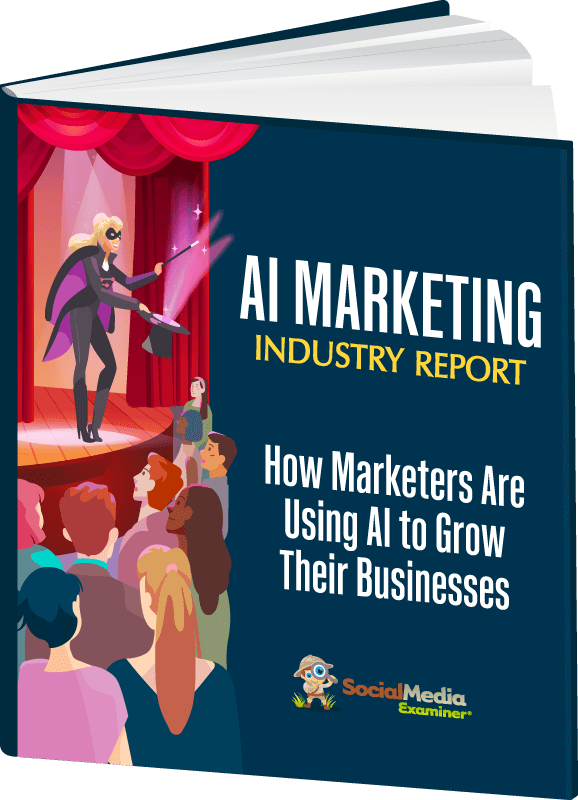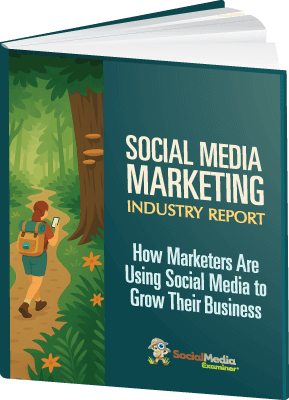Are you overwhelmed by repetitive marketing tasks that eat up your entire day? Wondering how AI automation could give you back time to focus on what really matters in your business?
In this article, you'll discover how to use AI automation to streamline your marketing and social media workflows.
Why AI Automation Matters for Marketing and Social Media
AI automation offers more than just time savings. When implemented properly, it allows small businesses to operate like larger organizations without the overhead of managing a big team.
“We show people how to use AI for automations, for basically creating a team of mini thems that can do the work for them so that they're not spending all their time behind the desk,” explains Brittany Long, founder of Impact Driven AI and host of the Doable with AI podcast. Long transitioned from copywriting to AI training after recognizing ChatGPT's potential when it launched in late November 2022. She made the career pivot within just one week of the platform's release.
The value of automation goes beyond saving time. It allows you to create what Long describes as clones of yourself that can handle routine tasks while maintaining your voice and standards. This becomes especially valuable when you consider how much time business owners spend on repetitive tasks that prevent them from focusing on strategic growth.
#1: Where to Begin with Automation: Conduct Your Time Study and Organize Your Tasks
Before automating any part of your business, you need to understand where your time actually goes. Long emphasizes that this first step is often skipped by business owners eager to jump into automation tools. The process starts with what she calls a time study—a detailed record of how you spend your workday.
To conduct your time study, create a spreadsheet and document what you do every fifteen minutes throughout your day. Include both personal and professional activities. This detailed tracking might seem excessive, but it's essential for identifying patterns and automation opportunities. Long recommends tracking everything because personal tasks often overlap with professional time, and understanding the complete picture helps you make better automation decisions.
“I know that it sounds so crazy and boring and just mind-numbing to actually do that,” Long acknowledges, “but really understanding where your time goes and then analyzing it is really where you start to see, whoa, I didn't realize I spent four hours a week on this or I didn't realize I spent an hour every day on social media scheduling.”
The tracking process often reveals surprising insights. Many business owners discover they're spending hours on tasks they thought took minutes, or they're switching between activities so frequently that they're losing productivity. This understanding becomes the foundation for smart automation decisions.
After collecting a week's worth of data, the analysis begins. Long recommends using ChatGPT to help analyze your time tracking data and identify automation opportunities. You can upload your spreadsheet directly to ChatGPT and ask it to categorize your tasks based on their impact and effort level.
The AI will help you organize tasks into categories that guide your automation strategy. High impact, low lift tasks are your first automation priorities. These are activities that contribute significantly to your business goals but don't require complex human judgment. Medium impact, low lift tasks come next, followed by high impact, medium lift activities. This categorization helps you avoid trying to automate everything at once.
After categorizing by impact and effort, you need to decide what happens to each task. Long uses a framework of delete, delegate, or automate. Some tasks turn out to be unnecessary and can be eliminated. Others are better suited for human team members. The remaining tasks become candidates for AI automation.
Using AI to analyze your time study helps identify patterns you might miss. ChatGPT can spot repetitive task sequences that could be combined into a single automation, or suggest eliminating steps that don't add value. This approach ensures you're not just automating current inefficiencies but actually improving your workflows.
Identify High-Impact Tasks for Automation
After completing your time study analysis, select which high-impact, low-lift tasks to automate first. Long emphasizes that social media posting and marketing program promotion are excellent starting points because they're repetitive, time-consuming, and follow predictable patterns.
Ready to Supercharge Your Marketing Strategy?

Get expert training and an unbeatable conference experience when you attend Social Media Marketing World—from your friends at Social Media Examiner.
Broaden your reach, skyrocket your engagement, and grow your sales. Become the marketing hero your company or clients need!
🔥 Save $850 on an All-Access ticket. Sale Ends Tuesday! 🔥
GET THE DETAILSEmail automation is one of the most powerful and accessible entry points. Long describes a system where voice notes or form submissions can trigger entire email sequences, complete with personalized responses and follow-ups. These automations have evolved significantly with AI agents, which can now take actions on your behalf rather than just processing information.
For example, instead of just drafting email responses and placing them in a folder for review, modern AI automation can analyze incoming emails, create appropriate responses, check those responses for accuracy, and send you a Slack message with the proposed response. You simply click yes or no, and the system handles the rest, including scheduling follow-ups if needed. This represents a shift from automation as a processing tool to automation as an intelligent assistant.
Social media automation offers another high-impact opportunity. Long works with entrepreneurs who previously spent hours each week creating and scheduling social media content. Through automation, this process can be reduced to minutes. The key is setting up systems that maintain your authentic voice while handling the mechanical aspects of content distribution.
Marketing program promotion works well for automation because it involves repeating similar messages across multiple channels with slight variations. Rather than manually adapting your core message for each platform, automation can handle the reformatting while maintaining your brand voice and key messaging.
#2: Build Your First Automation with Make
Creating automations has become more accessible thanks to platforms like Make, which Long describes as user-friendly for beginners. Make offers an AI beta feature that helps you build automations even without a technical background. The platform's visual interface shows how data flows through your automation, making it easier to understand and fix problems.
To build your first automation in Make, start by creating what's called a scenario—a workflow that connects different applications and services. The platform's AI beta feature can suggest scenario structures based on what you want to accomplish. For instance, if you want to automate social media posting from voice notes, you would start by setting up a trigger.
For a voice note automation system, the trigger might be uploading a voice note to a specific Google Drive folder. When Make detects a new file in that folder, it downloads the file and sends it to a transcription service. The transcript then gets processed through ChatGPT or Claude, which transforms it into social media posts for different platforms.
Make represents each step in your automation as a visual module, and you can see data passing between modules. This transparency makes it easier to identify problems and modify your automations as needs change.
When building automations, Long emphasizes starting simple and gradually adding complexity. Your first automation might just take a voice note and create a single social media post. Once that works reliably, you can add steps to create variations for different platforms, schedule posts for optimal times, or analyze engagement and adjust future content.
API keys are crucial when integrating AI tools like ChatGPT. Long directs users to platform.openai.com to obtain their API keys, which allow Make to communicate with OpenAI's services. While API keys might sound technical, Long explains they're simply like passwords that allow different services to connect. The process is straightforward, and most platforms provide clear instructions.
Pro Tip: To help debug automations. You can take a screenshot of your Make scenario and upload it to ChatGPT with a description of the problem. The AI can often identify configuration issues or suggest solutions based on the visual information. This troubleshooting approach has saved Long and her clients significant time.
Create Advanced Automations With Agent Mode
The evolution from simple automation to what Long calls agent mode represents a major shift in how AI supports your business. Traditional automation follows predetermined rules, but agents can make decisions and take actions based on context and goals. This distinction becomes important as you scale your automation efforts.
AI Is No Longer Optional for Marketers—Ready to Master It?

Join over a thousand forward-thinking marketers at AI Business World—a conference-in-a-conference at Social Media Marketing World.
Get two days of practical AI training where you'll discover:
✅ Systems that 3x your output—leaving time for strategy and creativity
✅ Proven strategies you can deploy right away—no guesswork, no wasted budget
Become the indispensable AI expert your company needs.
GET YOUR TICKETS—SAVE $350Long explains that agents add intelligence layers to automations. Where basic automation might read an email and create a draft response, an agent-based system can read the email, understand context, check previous communications, craft an appropriate response, verify it meets your standards, and determine the best next action. This might include sending the response immediately, scheduling it for later, or flagging it for human review.
The power of agent mode shows in complex workflows. Long describes a system where an email arrives and the automation not only drafts a response but also checks it against your communication guidelines, ensures it matches your brand voice, and considers factors like time of day and the recipient's history. The system then makes intelligent decisions about whether to send the email, create a follow-up task, or escalate to a human team member.
This sophistication extends to social media automation. Rather than just posting content at set times, agent-based systems can analyze engagement patterns, adjust posting schedules dynamically, and modify content based on performance. The system becomes less rigid and more like an intelligent assistant that learns and adapts.
Managing the Human Side of Automation
One overlooked aspect of implementing automation is managing the human element, especially when you have team members who might feel threatened by AI taking over tasks. Long has developed an approach that positions AI as a tool that enhances human capabilities rather than replacing workers.
Team members' fears are understandable. They see online discussions about AI replacing workers and worry about job security. Long addresses this by first understanding each team member's personality and concerns. She uses tools like the Enneagram personality system to understand how different people process change and what motivates them.
“I look at their Enneagram, I look at different personality tests they've taken to see how to best approach it with them,” Long explains. She then uses ChatGPT to help craft communications that address each team member's specific concerns and highlight how automation will benefit them personally.
The key message Long conveys is that automation handles mundane, repetitive tasks that nobody enjoys, freeing humans for more creative, strategic, and fulfilling work. She positions AI and human workers as a power couple that together accomplish more than either could alone.
Long shares an example from her own team. She has team members named Cindy and Judy, who initially worried about job security when automation was introduced. Once they saw that automation handled the boring tasks they disliked, they could focus on creative and strategic work. They moved from routine data entry and basic content creation to developing strategies, building client relationships, and working on innovative projects.
The transformation in team dynamics is significant when automation is implemented thoughtfully. Team members who previously spent hours on mundane tasks like data entry or routine posting can focus on activities requiring human creativity, empathy, and strategic thinking. This shift improves job satisfaction and increases the value each team member brings.
Long emphasizes that successful implementation requires transparent communication about how roles will evolve. Rather than surprising team members with sudden changes, she recommends involving them in the automation planning process. When team members understand they're being elevated to more important work, they often become automation champions rather than resisters.
To facilitate this transition, Long recommends assigning specific valuable tasks to team members that showcase their unique human capabilities. These might include relationship building, creative problem-solving, strategic planning, or any area where human judgment provides irreplaceable value. By clearly defining these new responsibilities, team members can see a clear path forward.
#3: Practical Implementation: Turn Voice Notes Into Published Content
To illustrate how these concepts work together, Long walks through a complete automation example that many marketers will find immediately useful. The scenario involves using voice notes to create social media content—a process that traditionally takes hours but can be reduced to minutes through automation.
The workflow begins with recording a voice note on your phone while walking, driving, or whenever inspiration strikes. You upload this voice note to a designated Google Drive folder, which triggers your Make automation. The automation detects the new file, downloads it, and sends it to a transcription service.
Once transcribed, the text goes to an AI model like ChatGPT or Claude, along with instructions about your brand voice, target audience, and content requirements. The AI transforms your casual voice note into polished social media posts, creating variations for different platforms. A single five-minute voice note might become a LinkedIn article, three X posts, an Instagram caption, and a Facebook update, each optimized for its platform while maintaining your core message.
The automation can go further, scheduling posts at optimal times based on engagement data, adding relevant hashtags, and even creating simple graphics. What might have taken two hours happens automatically in the background while you focus on other priorities.
This sophistication isn't built overnight. You start with a simple version—perhaps just transcribing voice notes and creating basic posts. As you become comfortable with the technology and refine your prompts, you can add layers of complexity to match your needs.
#4: Troubleshooting and Optimization Tips
Even with good planning, automations occasionally encounter issues. Long has developed strategies for quickly identifying and resolving problems. Her primary debugging technique involves taking screenshots of the problematic automation in Make and uploading them to ChatGPT with a description of what's going wrong.
ChatGPT can analyze the screenshot and identify common issues like incorrect module settings, missing connections, or data formatting problems. It can suggest specific fixes or alternative approaches. This method turns ChatGPT into technical support that's available twenty-four seven and becomes more helpful over time.
When working with API integrations, Long recommends keeping detailed documentation of your API keys and their permissions. She suggests using a password manager to store these securely and maintaining a spreadsheet that tracks which automations use which APIs. This organization becomes crucial as you build more complex systems.
Regular testing and monitoring are essential for reliable automations. Long recommends setting up test scenarios where you can run automations with sample data before deploying them with real content. This allows you to catch issues before they affect your actual marketing efforts. She also suggests implementing notification systems that alert you when automations fail or produce unexpected results.
Optimization is ongoing. As you gather data about automation performance, you can refine it for better results. This might mean adjusting AI prompts, changing posting timing, or adding steps to handle edge cases. Long emphasizes that the goal isn't perfection from the start but continuous improvement.
Brittany Long is an AI trainer who helps ambitious entrepreneurs scale their businesses with AI to live a regret-free life. She's the founder of Impact Driven AI and host of the Doable with AI podcast. Learn more about her automation programs at AICoachOnDemand.com. Follow her on Instagram and YouTube.
Other Notes From This Episode
- Connect with Michael Stelzner @Stelzner on Facebook and @Mike_Stelzner on X.
- Watch this interview and other exclusive content from Social Media Examiner on YouTube.
Listen to the Podcast Now
This article is sourced from the AI Explored podcast. Listen or subscribe below.
Where to subscribe: Apple Podcasts | Spotify | YouTube Music | YouTube | Amazon Music | RSS
✋🏽 If you enjoyed this episode of the AI Explored podcast, please head over to Apple Podcasts, leave a rating, write a review, and subscribe.
Stay Up-to-Date: Get New Marketing Articles Delivered to You!
Don't miss out on upcoming social media marketing insights and strategies! Sign up to receive notifications when we publish new articles on Social Media Examiner. Our expertly crafted content will help you stay ahead of the curve and drive results for your business. Click the link below to sign up now and receive our annual report!
AI Is Transforming Marketing—Are You Keeping Up?

Marketers are rapidly adopting AI to transform their work. Our new 2025 AI Marketing Industry Report surveyed over 730 marketers to reveal the tools, tactics, and trends shaping the industry, including
🔥 90% of marketers save time with AI—discover the top use cases
🔥 The 5 biggest challenges marketers face with AI and how to overcome them
GET THE AI MARKETING INDUSTRY REPORT

